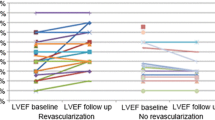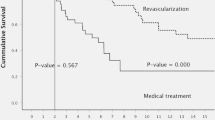Abstract
To evaluate the prognostic significance of combined myocardial perfusion SPECT and [18F]FDG PET viability scanning for the prediction of survival in patients with ischemic cardiomyopathy (iCMP) and left ventricular dysfunction. 244 patients (64.0 ± 10.6 years, 86 % men) with iCMP and LVEF ≤45 % underwent SPECT/PET. Percent scar tissue and SPECT/PET-mismatch (%-mismatch) were calculated and correlated with event-free survival according to the type of therapy (medical therapy with/out revascularization) provided after imaging. Death from any cause was defined as the primary endpoint. Early revascularization (ER) was performed in 113/244 (46 %) patients within 32 ± 52 days (26 bypass surgeries and 87 percutaneous coronary interventions). 65 patients died during follow-up for a median of 33 months. Kaplan–Meier analysis showed that those patients with ≥5 % mismatch not undergoing ER had significantly higher mortality than did the group with similar mismatch who did receive ER. Cox analysis identified both SPECT/PET-mismatch and the interaction of SPECT/PET-mismatch with ER as independent predictors for death due to all causes. A threshold of ≥5 % SPECT/PET-mismatch predicted best which patients with iCMP and LV dysfunction would benefit from ER in terms of long-term survival.




Similar content being viewed by others
Abbreviations
- ACD:
-
All cause death
- AUC:
-
Area under the curve
- CABG:
-
Coronary artery bypass graft
- CD:
-
Cardiac death
- CR:
-
Cardiac revascularization
- ER:
-
Early revascularization
- iCMP:
-
Ischemic cardiomyopathy
- LVEF:
-
Left ventricular ejection fraction
- MI:
-
Myocardial infarction
- PCI:
-
Percutaneous coronary intervention
- PET:
-
Positron emission tomography
- SPECT:
-
Single photon emission computed tomography
References
Bonow RO, Maurer G, Lee KL et al (2011) Myocardial viability and survival in ischemic left ventricular dysfunction. N Engl J Med 364:1617–1625
Camici PG, Prasad SK, Rimoldi OE (2008) Stunning, hibernation, and assessment of myocardial viability. Circulation 117:103–114
Underwood SR, Bax JJ, vom Dahl J et al (2004) Imaging techniques for the assessment of myocardial hibernation. Report of a Study Group of the European Society of Cardiology. Eur Heart J 25:815–836
Schinkel AF, Bax JJ, Poldermans D, Elhendy A, Ferrari R, Rahimtoola SH (2007) Hibernating myocardium: diagnosis and patient outcomes. Curr Probl Cardiol 32:375–410
Tarakji KG, Brunken R, McCarthy PM et al (2006) Myocardial viability testing and the effect of early intervention in patients with advanced left ventricular systolic dysfunction. Circulation 113:230–237
Zhang X, Liu XJ, Wu Q et al (2001) Clinical outcome of patients with previous myocardial infarction and left ventricular dysfunction assessed with myocardial (99 m)Tc-MIBI SPECT and (18)F-FDG PET. J Nucl Med 42:1166–1173
Beanlands RS, Nichol G, Huszti E et al (2007) F-18-fluorodeoxyglucose positron emission tomography imaging-assisted management of patients with severe left ventricular dysfunction and suspected coronary disease: a randomized, controlled trial (PARR-2). J Am Coll Cardiol 50:2002–2012
Bax JJ, Visser FC, Poldermans D et al (2001) Relationship between preoperative viability and postoperative improvement in LVEF and heart failure symptoms. J Nucl Med 42:79–86
Kuhl HP, Lipke CS, Krombach GA et al (2006) Assessment of reversible myocardial dysfunction in chronic ischaemic heart disease: comparison of contrast-enhanced cardiovascular magnetic resonance and a combined positron emission tomography-single photon emission computed tomography imaging protocol. Eur Heart J 27:846–853
Pace L, Perrone-Filardi P, Storto G et al (2000) Prediction of improvement in global left ventricular function in patients with chronic coronary artery disease and impaired left ventricular function: rest thallium-201 SPET versus low-dose dobutamine echocardiography. Eur J Nucl Med 27:1740–1746
Slart RH, Bax JJ, van Veldhuisen DJ et al (2006) Prediction of functional recovery after revascularization in patients with chronic ischaemic left ventricular dysfunction: head-to-head comparison between 99mTc-sestamibi/18F-FDG DISA SPECT and 13 N-ammonia/18F-FDG PET. Eur J Nucl Med Mol Imag 33:716–723
Bax JJ, Visser FC, van Lingen A, Cornel JH, Fioretti PM, van der Wall EE (1997) Metabolic imaging using F18-fluorodeoxyglucose to assess myocardial viability. Int J Card Imag 13:145–155 Discussion 157–160
Slomka PJ, Nishina H, Berman DS et al (2004) Automatic quantification of myocardial perfusion stress-rest change: a new measure of ischemia. J Nucl Med 45:183–191
Beanlands RS, Ruddy TD, de Kemp RA (2002) Positron emission tomography and recovery following revascularization (PARR-1): the importance of scar and the development of a prediction rule for the degree of recovery of left ventricular function. J Am Coll Cardiol 40:1735–1743
Slomka PJ, Nishina H, Berman DS et al (2005) Automated quantification of myocardial perfusion SPECT using simplified normal limits. J Nucl Cardiol 12:66–77
Gottlieb SS (1997) Dead is dead–artificial definitions are no substitute. Lancet 349:662–663
Lauer MS, Blackstone EH, Young JB, Topol EJ (1999) Cause of death in clinical research: time for a reassessment? J Am Coll Cardiol 34:618–620
Dickstein K, Cohen-Solal A, Filippatos G et al (2008) ESC guidelines for the diagnosis and treatment of acute and chronic heart failure 2008: the task force for the diagnosis and treatment of acute and chronic heart failure 2008 of the European Society of Cardiology. Developed in collaboration with the heart failure association of the ESC (HFA) and endorsed by the European Society of Intensive Care Medicine (ESICM). Eur J Heart Fail 10:933–989
Velazquez EJ, Lee KL, Deja MA et al (2011) Coronary-artery bypass surgery in patients with left ventricular dysfunction. N Engl J Med 364:1607–1616
D’Egidio G, Nichol G, Williams KA et al (2009) Increasing benefit from revascularization is associated with increasing amounts of myocardial hibernation: a substudy of the PARR-2 trial. JACC Cardiovasc Imag 2:1060–1068
Desideri A, Cortigiani L, Christen AI et al (2005) The extent of perfusion-F18-fluorodeoxyglucose positron emission tomography mismatch determines mortality in medically treated patients with chronic ischemic left ventricular dysfunction. J Am Coll Cardiol 46:1264–1269
Di Carli MF, Davidson M, Little R et al (1994) Value of metabolic imaging with positron emission tomography for evaluating prognosis in patients with coronary artery disease and left ventricular dysfunction. Am J Cardiol 73:527–533
Lee KS, Marwick TH, Cook SA et al (1994) Prognosis of patients with left ventricular dysfunction, with and without viable myocardium after myocardial infarction. Relative efficacy of medical therapy and revascularization. Circulation 90:2687–2694
Hachamovitch R, Hayes SW, Friedman JD, Cohen I, Berman DS (2003) Comparison of the short-term survival benefit associated with revascularization compared with medical therapy in patients with no prior coronary artery disease undergoing stress myocardial perfusion single photon emission computed tomography. Circulation 107:2900-7. Epub 2003 May 27
Canty JM Jr, Suzuki G, Banas MD, Verheyen F, Borgers M, Fallavollita JA (2004) Hibernating myocardium: chronically adapted to ischemia but vulnerable to sudden death. Circ Res 94:1142–1149
Nkoulou R, Pazhenkottil AP, Buechel RR et al (2011) Impact of CT attenuation correction on the viability pattern assessed by 99mTc-tetrofosmin SPECT/18F-FDG PET. Int J Cardiovasc Imag 27:913–921
Acknowledgments
A substantial part of this work originated from the doctoral thesis of cand. med. Stefan Hellweger.
Conflict of interest
Cedars-Sinai Medical Center receives royalties for the licensure of software used in the quantitative assessment of function, perfusion, and viability, a portion of which is distributed to some of the authors of this article.
Author information
Authors and Affiliations
Corresponding author
Rights and permissions
About this article
Cite this article
Uebleis, C., Hellweger, S., Laubender, R.P. et al. The amount of dysfunctional but viable myocardium predicts long-term survival in patients with ischemic cardiomyopathy and left ventricular dysfunction. Int J Cardiovasc Imaging 29, 1645–1653 (2013). https://doi.org/10.1007/s10554-013-0254-2
Received:
Accepted:
Published:
Issue Date:
DOI: https://doi.org/10.1007/s10554-013-0254-2




